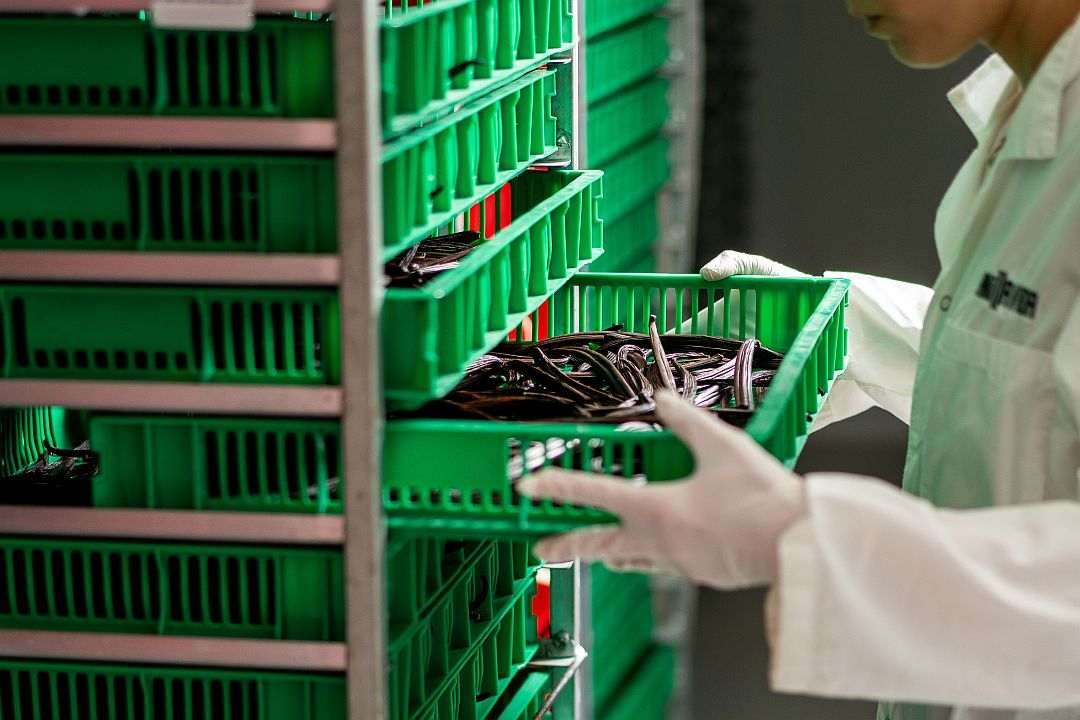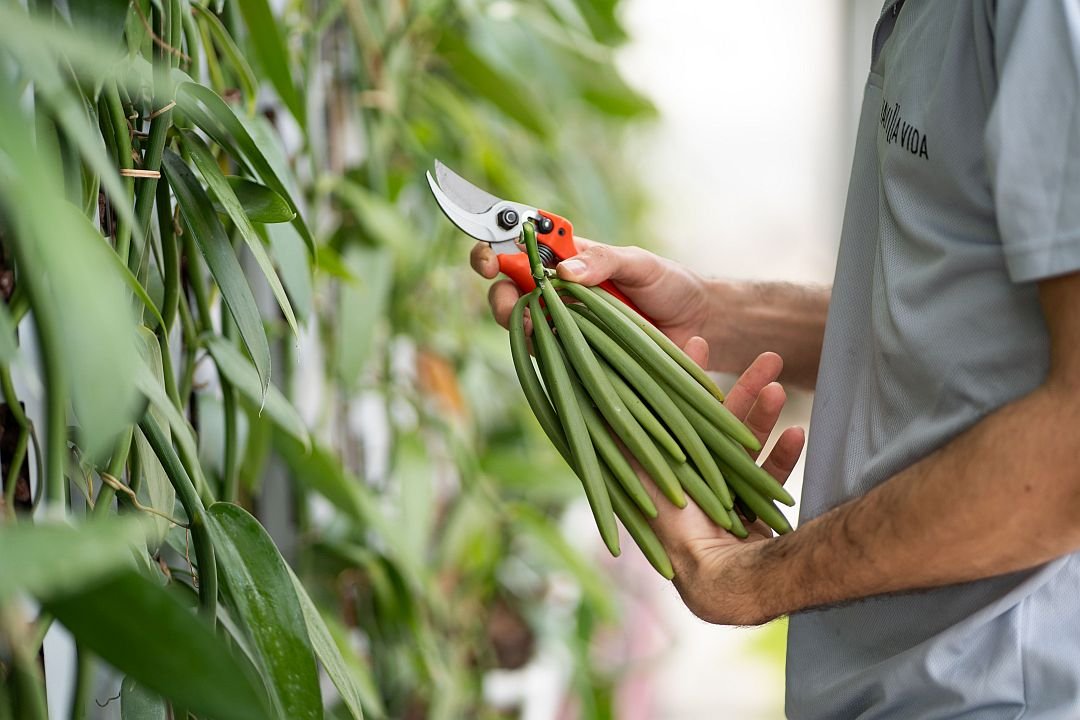Vanilla Vida—an Israeli startup addressing the vast mismatch between supply and demand in the natural vanilla market—is establishing a 10-hectare facility in Uganda featuring its proprietary indoor vanilla cultivation and curing technology.
It has also raised a $3.5 million internal funding round led by Windare Ventures to support the Uganda buildout and accelerate its broader scale-up plans, said the firm, which has pioneered a growing system that halves the time from planting to bloom and delivers higher yields of vanillin.
The project in Uganda, where Vanilla Vida already sources some beans that it cures in Israel, will be developed in partnership with local communities and will secure a reliable year-round supply of premium vanilla.
The site “marks a pivotal step in Vanilla Vida’s mission to disrupt and rebuild the global vanilla supply chain, moving from proven technology to large-scale commercial execution,” CEO Ilanit Bar Zeev told AgFunderNews.
“The first planting at our Uganda pilot facility is scheduled for early 2026. Vanilla Vida’s optimized CEA [controlled environment agriculture] protocol shortens the growth cycle significantly compared to traditional open-field farming, where it typically takes four to five years. Our first meaningful harvest is expected about three years after planting in 2029.”
In the second half of 2026, she added, the Uganda curing facility will run on a hybrid model, initially curing green beans sourced from Ugandan farmers and gradually transitioning to a combination of local partners and Vanilla Vida’s own production as the plantations mature.
“Uganda offers the ideal conditions and partnerships to showcase our ability to deliver stable, sustainable vanilla at scale.” Yoni Glickman, chairman, Vanilla Vida

Global expansion
The first beans from Vanilla Vida’s facilities in the north of Israel were harvested in January, with crops from additional greenhouses run by joint venture partners in central and southern Israel using Vanilla Vida systems and protocols set to deliver harvests in late 2025 and early 2026.
Under agreements with its partners, Vanilla Vida supplies young plants to farmers who grow them using its protocols and sell the beans back to Vanilla Vida for curing. It also operates a ‘hybrid’ model whereby it can source beans from vanilla plants grown outdoors and then cure them in its facilities.
Vanilla Vida—which has raised around $18 million to date from investors include Windare Ventures , PeakBridge FoodSparks, Arancia International, Paneurinvest, and Oceale Investments—is seeking to scale its tech globally, said Bar Zeev.
“In addition to Israel and Uganda, we are in advanced partnership discussions in two additional countries. Both regions are part of our long-term plan to scale to ~60 hectares globally, targeting ~10% of the world’s natural vanilla supply. The approach is selective: only with partners that align with our model of vertically integrated, climate-independent, and fully traceable vanilla production.”
She added: “Sales have tripled year-on-year since 2022, all at premium pricing of ~1.5× the market average. Our Uganda’s first commercial run is already booked.”
‘Our beans consistently reach >3% vanillin content’
Unlike players producing natural vanillin from bioconversion of ferulic acid from rice bran (which is not the same as vanilla extracts from vanilla plants but can be listed as ‘natural flavor’) Vanilla Vida is growing vanilla planifolia plants indoors in climate-controlled greenhouses. This will add to the world’s supply of vanilla beans, for which demand dramatically exceeds supply.
Vanilla Vida’s plants are not genetically engineered, but thanks to a precisely controlled environment, saplings become mature and productive in two years rather than four. In addition, the traditional six-month-long curing process for the pods can be halved.
Using these methods, yields of vanillin, the primary flavoring component in the crop, are also typically far higher than the average of around 1-2%. Most of this increase is achieved during the curing process.
As such, clients getting vanilla from beans cured by Vanilla Vida but grown from vanilla plants grown outdoors by its partners, can get vanillin content of above 3%. This number could potentially be even higher from beans that are grown using the company’s proprietary indoor growing system, said Bar Zeev. “Our beans consistently reach >3% vanillin content and the curing efficiency is double the industry’s average.”
That said, the consistent quality and custom flavors that Vanilla Vida can deliver is more important to customers than the percentage of vanillin alone, says the firm, noting that modifying the environment during curing can bring out more chocolatey, smoky, or caramel notes for example.

The vanilla market
Right now, consumer goods companies seeking vanilla flavors have several options:
- Vanilla beans/extracts, which come with a hefty price tag but a consumer-friendly label;
- Vanillin from petrochemicals, which dominates the market but is considered an ‘artificial flavor;’
- Vanillin from bioconversion of ferulic acid in rice bran (or other sources) that can be labeled as a ‘natural flavor.’ This market is led by Syensqo (spun out of Solvay), but does not have the same sensory properties as the full extract and typically needs to be further processed by flavor houses;
- Vanillin from cloves to wood pulp to conifers, which may or may not be considered natural depending on how it’s processed and where it’s sold;
- Vanillin produced by genetically engineered baker’s yeast via precision fermentation, which is considered natural in some jurisdictions but not in others. This has not yet been successfully scaled.
Yoni Glickman, a board member at Vanilla Vida and managing partner at FoodSparks, an early stage venture capital fund managed by EIT Food and PeakBridge, told AgFunderNews in a recent interview that he expected vanilla prices to “continue to be highly volatile, driven by the same structural forces that have shaped cocoa and coffee markets: climate change, supply chain disruptions, and shifting consumer preferences and demand.
“While cocoa and coffee have seen broader geographic diversification, providing somewhat more resilience, total vanilla volume is far smaller and remains heavily concentrated in Madagascar, creating extreme supply sensitivity.”
Against that backdrop, he said, the market opportunity for a company supplying ‘real’ vanilla that can be labeled as such is vast.
The post Exclusive: Vanilla Vida to establish full-scale integrated growing and curing facility in Uganda appeared first on AgFunderNews.














